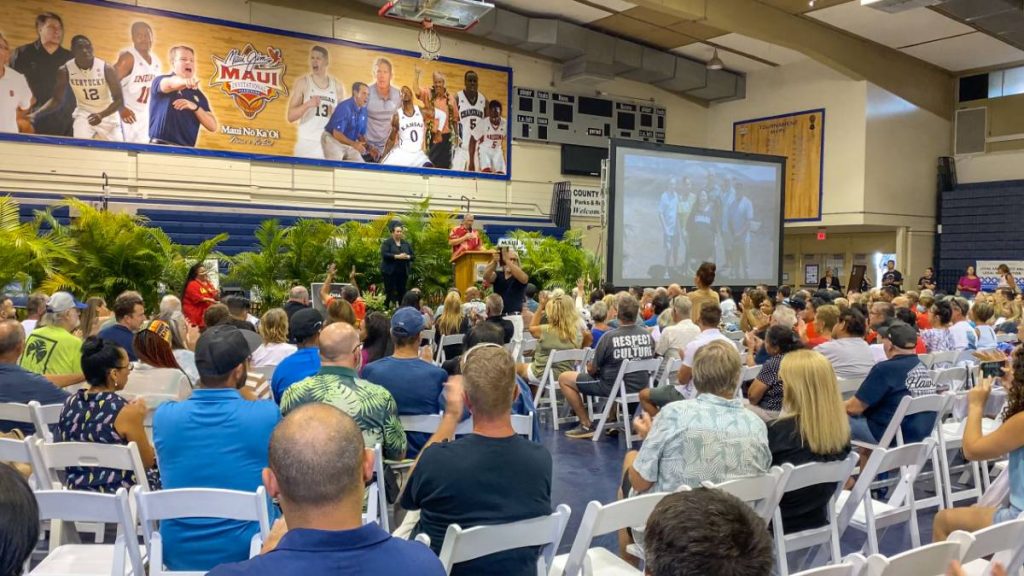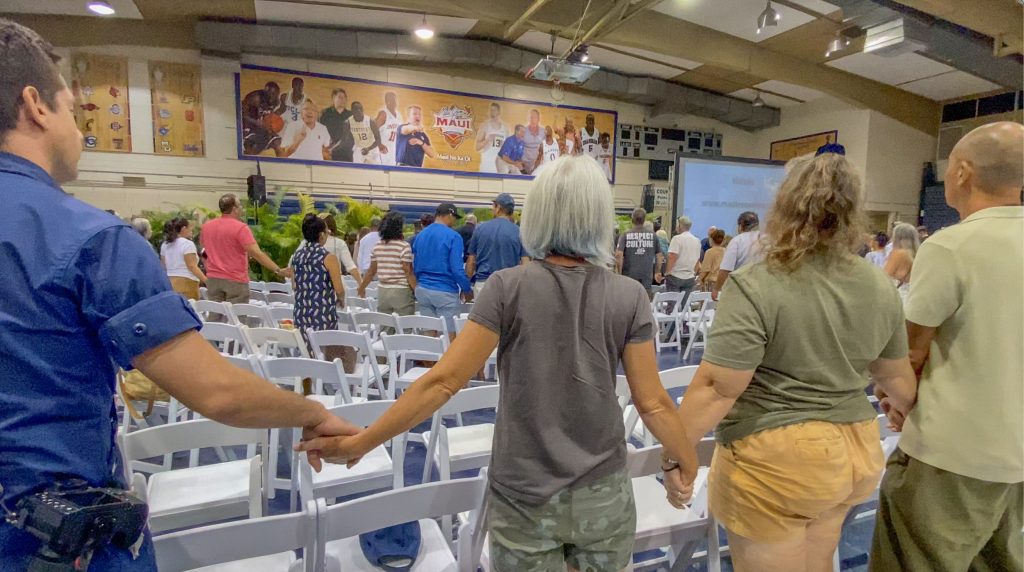Lahaina comes together in community meeting to get recovery information, share hope

Maui Mayor Richard Bissen did not sugarcoat what everyone in Lahaina, and around the island, already knows: Recovery from the destructive and most deadly U.S. fire in a century is “going to be a very heavy lift.”
But he added: “The work is lighter with many hands.”
Some of those many hands — and most of the key leaders of the recovery effort — spoke Friday night before about 600 people at the Lahaina Civic Center. It was the first Maui County community meeting held in Lahaina since the fires of Aug. 8.
“Our goal tonight is to get information to you so you can stabilize what has been an uncertain period full of anxiety,” Bissen said.
The gathering was emotional at times, with photos and names of the 76 identified deceased scrolled on a screen in the front of the arena. Rick Nava, a member of the newly created Lahaina Advisory Team, choked up while detailing his own family’s narrow escape from the fire.
“I shared the story of how close we were to losing our family — but we made it,” he said. “My mother-in-law [is] 93 years old. We made sure she was in the car. My two grandsons made sure we were in the car. We were able to get out of there with maybe a minute left when we saw our house burning.”
His home was among the 2,200 structures, most of them residences, that was destroyed by the fire. Hundreds more were damaged.
It’s why one of the biggest issues for most fire survivors at this time is temporary housing on an island that already had an affordable housing crisis before the destruction.
Now, 7,600 people are living in more than 40 hotels in a program operated by the Red Cross with funding from FEMA.
Many are concerned that they will be kicked out of the hotels when West Maui officially reopens to visitors on Oct. 8, a date selected by Hawaiʻ Gov. Josh Green.
Bissen said the Lahaina Advisory Team was put together to help plan that reopening: “We on Maui. We in Lahaina.”
The advisory team is made up of long-time community members who understand the town’s cultural and historic fabric — and its pain, having lost homes and loved ones themselves.
“They do not have a seat at the table,” Bissen said. “They sit at the head of the table. They will be the ones guiding us as we move forward.”
The crowd clapped.
Bissen reiterated what Green said the day before: no fire survivors will be displaced by tourists.
“Oct. 8 has nothing to do with anyone’s housing,” Bissen said.
FEMA’s Bob Fenton, who is heading up the federal response to the Maui Recovery, said the goal now is to get people into better temporary living conditions.
“A hotel is much better than being in a gym on a cot, but we really want to get you back to where you can be in an apartment or home,” he said. “Get you into a rental.”
But rentals are scarce on Maui, even with uninsured home owners and renters able to receive an average of about $3,500 per month of rental assistance.
Fenton said he is working on a contract for the government to lease out units, or rent a big complex, and then sublease it to fire survivors. A third option, more of a last resort, is to build temporary modular homes.
For now, Fenton said there is plenty of capacity of hotel rooms, which eligible people can stay in up to six months (until Feb. 10).
The American Red Cross also is working to ensure that everyone has housing, which includes people with immigration status issues.
“We are not a government agency and are able to provide assistance to all,” said David Gutierrez, director of the Red Cross disaster relief operations on Maui. “We do not share immigration information.”
Another big part of the recovery occurring now is the start of reentry into residential areas, which is being led by Darryl Oliveira, interim director of the Maui Emergency Management Agency.
It will be done by zones, with property owners and residents of Zone 1C — Kaniau Road — to be the first to be able to go into the impact zone, starting Monday. The reentry program requires registering and picking up vehicle passes.
Also introduced at the meeting was Josiah Nishita, who Bissen chose to lead the county’s new Office of Recovery. Nishita had been overseeing 17 departments at the county as its deputy director of the Department of Management.
Nishita, who is Maui born and raised, started with some good news. On Saturday, Launiupoko Beach Park “is being given back to the community.” It’s reopening is a step in many to come.
“I have been asked to lead the recovery efforts for the monumental mission that’s before us,” Nishita said. “For the county and our West Maui community, there may be no greater community-led effort and work in our lifetimes than what we will all be embarking on together.
“The significance and ramifications of the decisions that this community will make for all of your homes will undoubtedly impact generations to come.”
Nishita said the job of the recovery office is “to listen, to learn and to assist in the implementation of your community’s vision for Lahaina.”
Realistically, it will be 1 1/2 to 2 years before building can start in the burned zone, Bissen said.
Recovery has to be done in phases, which began with the search and rescue mission. Bissen said it originally was estimated to take 8 to 12 weeks. But with an influx of searchers and cadaver dogs (from 1 team of 90 people and about 9 dogs to 450 people and 43 dogs), it was completed in three weeks.
The current phase, in which the US Environmental Protection Agency is leading the removal of hazardous waste, started Aug. 26 with three teams and now is up to nine. In less than a month, the toxic cleanup portion is about 50% completed, said Steve Calanog, an on-scene coordinator with the EPA.
The next phase will be the overall debris cleanup, which is being led by the US Army Corps of Engineers.
Col. Jess T. Curry, who is leading the cleanup on Maui, reiterated that like the hazardous clean up phase, cultural monitors will be in place during throughout the process. But unlike the hazardous cleanup phase, property owners must provide written consent for any regular debris cleanup on their property.
The community also received updates and information about other issues and concerns.
Bissen said he realized that many people are worried about the reopening of West Maui for visitors, which means many people will be going back to work and don’t know what they are going to do about childcare.

He said the county is currently working with the Hawaiʻi Community Foundation and other partners on this issue.
Regarding air quality, Department of Health director Dr. Kenneth Fink said the major concern is toxins in the ash. The air quality that has been monitored has so far had good results.
But he said with the beginning of reentry to the impact zone on Monday, people should be careful to limit the exposure to the ash and to try not to stir up the ash into the air.
Fink said an additional 70 air monitors will be added to the impact zone.
Regarding water, there was not great news. John Stufflebean, director of the county Department of Water, said while the water sources were not impacted by the Lahaina fire, the pipes in the distribution system were.
To get the water safe throughout the system will require many steps and testing.
“Itʻs going to take a while. Sorry to say that, itʻs kind of tough news, but this is a huge undertaking,” Stufflebean said.
He citing it took “a couple of years” for other places that suffered fire disasters, like Paradise, Calif., to regain a safe water supply for the town.
Regarding health and mental health, John Oliver with the Hawaiʻi Department of Health said West Maui Health Services has established temporary sites to provide services — and is working to establish a permanent site to provide needed medical, dental, optical, and mental health and substance abuse services.
Mental health services are be provided to survivors who are returning to see their destroyed homes and businesses.
For wellness checks of fire survivors staying in the hotels, Oliver said 17 beverage carts donated by Hawaiian Airlines are being used to go door-to-door. On the carts are daily donated fresh pineapple, which Oliver said brings smiles.
The meeting also was a chance to thank all the people who have been volunteering their time and making donations to help.
“We know over the past six weeks we have witnessed every kind of kindness from everyone around not just Maui and the State of Hawaiʻi, but in fact, from around the world,” Bissen said. “So again, our thanks to all of the kōkua (help) that has come from all our families, neighbors, businesses, nonprofits, churches, everyone.”
He also thanked to applause all the community distribution hubs, big and small.
“The outpouring has been as unprecedented as the crisis that has happened and the tragedy.”
At the end of the nearly two-hour meeting, people held hands and sang “Kuʻu One Hanau,” “Hawaiʻi Aloha,” the revered anthem of Native Hawaiians and Hawaiʻi residents.

Another community meeting with the same speakers will be held Sunday, from 3 to 5 p.m., at the Castle Theater at the Maui Arts & Cultural Center in Kahalu. The public can attend in person or watch live broadcasts on the county Facebook and Instagram pages or on Akakū Channel 53.
For more information about reentry and the recovery, go to mauirecovers.org.









